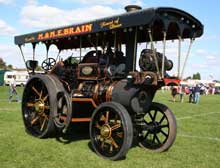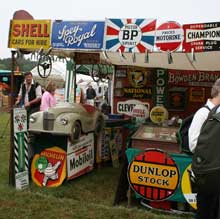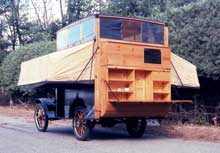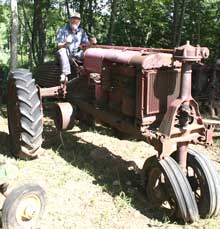Steam Fair
My favorite British vintage event, after Beaulieu Autojumble, is the Hanbury Steam Rally. Fortunately, the steam rally directly follows Beaulieu on the next weekend, so one can cover both events without losing any steam.
Stars of the Hanbury show, naturally, are the steam traction engines, which come in many flavors. The showman's engine was the mainstay of the carnival crowd, useful for pulling all sorts of fair equipment to a show and equipped with a generator for lighting and other electrical needs. The Pride of Worcester, an 8 horsepower Showman's Road Locomotive, was built in 1907 by C.Burrell & Sons, and has seen war service as well as show biz.
Ploughing engines were used to till the soil. Too heavy to pull a plough (they would pack the dirt), they ploughed in pairs, pulling the plough back and forth between them by means of a cable and winch. General purpose engines are useful for any number of tasks, such as threshing. Steam rollers, of course, are essential to any nation that travels. "Patricia," an Aveling-Barford, was used by Durham County Council from 1937 to 1963. Miniature traction engines were also represented.
Britain also had fleets of steam-powered lorries (trucks), and Hanbury had examples of the most popular Sentinel and Foden types. For good measure, there were a few petrol-powered rollers. And not forgotten was some real horsepower.
Fairground organs always give me goose bumps. Thankfully, Hanbury had several, including two Gaviolis, an 1890 89-key unit originally built for a European dance hall, and a 1902 98-key with ornate animated figures. I stood between them for about half an hour watching children ride the Helter Skelter, a kid-powered slide. Upon paying the entry, one picks up a mat, climbs the stairs and slides down on it, arriving promptly and excitedly at the bottom. It's ecofriendly, uses no hydrocarbons, and all who slide pay for the ride. Complementing the mechanized organs was a proper organ grinder, but, alas, no monkey.
The Hanbury rally is about more than steam, though. There are vintage bicycles, motorcycles (and at least a few scooters), military vehicles and tractors. Among the latter were several strongarm-type Fordsons (which we've examined before), a single-cylinder Field Marshall, even a John Deere. Stationary engines were there aplenty, pumping water, vacuum (for milking cows), and generating electricity. Celebrity of the lot was a monstrous V-12 diesel, whose dramatic contribution was simply to run.
You can't have a vintage event without vintage cars, and Hanbury had plenty, from Austin Seven to Morris Traveler, Wolseley to Jowett Javelin, even a barn-fresh Model T Ford. Steam cars were not forgotten. There was a solitary Stanley on display.
Because traction engines travel so slowly, workmen and showmen alike usually pulled their living quarters with them. Rally-goers still do. On display was a showman's living van, conveniently set out with all the comforts of home, even a showman's cat. Another genre of living van is the gypsy caravan, inevitably horsedrawn, several of which were on display.
Amongst all the glorious machinery, one could buy stuff, eat, drink and be merry. As the sun began to set I reluctantly took my leave. Hanbury is just off Junction 5 of the west country M5 motorway. Check it out next September.




